Reply To:
Name - Reply Comment
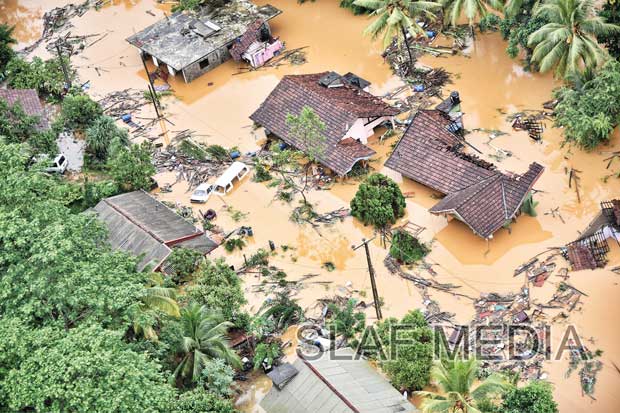

Despite being a land of rich biodiversity blended together with the ability to withstand harsh weather conditions, Sri Lanka today stands fragile and vulnerable to impacts of climate change.
Adding to the island nation’s burden of grief, the country recently faced a number of natural disasters with floods and landslides taking the forefront.The Daily Mirror spoke to experts representing the environment and Government sectors, in an attempt to gain a better insight into the causes that resulted in disastrous floods and how flooding could have been mitigated.

Speaking to the Daily Mirror, System Ecologist and Chairman of Rainforest Rescue International, Dr. Ranil Senanayake explained the main reasons behind the disastrous floods Sri Lanka experienced recently. According to him, the impact of climate change 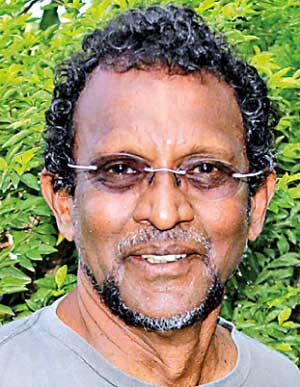 was listed as one of the main factors that gave rise to the recent flood.
was listed as one of the main factors that gave rise to the recent flood.
“There are many contributory factors that created the recent flood situation. One is the increase of extreme event frequency brought about by climate change. We will be exposed to both heavy rainfall events and strong drought events into the future. While it is the ‘developed’ countries, which have affected the climate most, we are making a bad situation worse by burning more coal, petrol, diesel and gas attempting to ape the destructive model of development promoted by businessmen and their political buddies,” Dr. Senanayake said.
Explaining the causes, he stated that the second reason was the weakening of the soil structures.
He said that this happened mainly due to the removal of forest covers and as a result of pouring chemicals that destroyed the life in the soil, which eventually led to robbing the soil of its cohesive strength.
What we can prevent is the massive loss of life and property at these events. We have to be ready for such events
“Next is the willy-nilly urbanisation with no consideration for the physical and cultural geography of a place. Neither the percentage of impervious surfaces created nor the amount of wetlands filled up is important to the greedy ‘developers’. With this comes the unchecked dumping of rubbish into the waterways.
“Another serious event is the blasting allowed for granite factoring. The shock waves from these blasting sites weaken the soil structures that overlay the rock base, making it easy for water to enter and liquefy the disturbed soil, creating the horrific landslides we have witnessed.
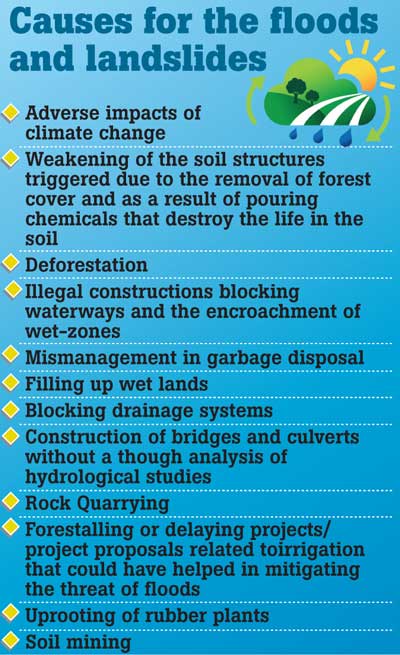
“Finally there is no organised official warning, nor response strategy to such events. We have a Climate Change Secretariat, whose responsibility is to model such extreme events and work with all arms of Government to be ready for these extreme events. Attending international conferences alone will not work!” he quipped.
When inquired if the flood was preventable by any means, Dr. Senanayake said that heavy rainfall would make such flood situations inevitable. He was of the view that since intense rainfall could not be prevented, the flooding accompanying such events could also not be prevented.
“What we can prevent is the massive loss of life and property at these events. We have to be ready for such events in the future and the Government must invest in a flood response plan as well as a drought response plan. The corporate sector as well as the public must be brought into these rapid response plans because as often as needed, these sectors can mobilise resources even faster than the Government.
“We should think about future flood events and begin designing houses on stilts as seen in much of Asia for flood-prone areas. The flood-prone areas should be identified and given an early warning system.
“We should instruct all Government representatives attending international conferences to fight for holding the global temperature under a 1.5 degree rise without compromise. We should stop clearing our forests and converting our lands from high biomass to low biomass, just to please some foreign ‘investors’ who have no interest in the well being of our people,” Dr. Senanayake added.

Director of Irrigation for Drainage and Flood Systems at the Irrigation Department, Eng. Janaki Meegasthenna said that the main reason for the blockages along rivers and flooding was a direct result of increase in the number of constructions along river banks, especially the construction of bridges, encroachment settlements in wet zones and construction of hotels along river sides.
Forestalling the projects due to protests by residents and political representatives have also played a crucial role..
“People dump garbage in the drains thereby blocking the drainage system including culverts. With the high intensity rain fall that we were receiving, the condition was further aggravated. Some of the road constructions including bridges and culverts have been built without analysing the rainfall trends, which is important according to hydrological studies. Also, forestalling the implementation of former projects/project proposals due to protests by residents and political representatives have also played a crucial role in giving rise to the recent floods.
“If these project proposals were implemented beforehand, the flood situation could have been mitigated to some length. If action was taken to initiate project proposals such as the Gin - Nilwala diversion to Hambantota, the third phase of the Nilwala River or if the needful was done to commence the work of the Mallawa reservoir, we could have mitigated the risk of floods to a greater extent,” she said.
“On the other hand, it should also be noted that the Sri Lankan irrigation systems needed to be improved because they are very old systems. These systems were designed BEFORE the impact of the climate change. I think now we need to improve our spill gates, canals and drainage canals. Nowadays, we have implemented the Climate Resilient Improvement Project. Under this project we have already started to improve the drainage system, spill gate canals and expand the existing tanks; especially in areas that are mostly affected by the flood. We are also improving tanks in areas such as Minneriya, Parakrama Samudraya, Giritale, Kawudulu including Nuwara, Tissa, Padaviya tanks and the Yoda Wewa complex,” Eng. Meegasthenna added.

Deputy Director of Geological Survey and Mines Bureau, Dr. C. H. E. R. Siriwardana elucidated that the Sri Lankan climate was controlled by the North East and South West Monsoons.
However, since geologically the central part of Sri Lanka was made out of particular rock types that were very resistant, the island held the ability to stand out under any weather condition, he said.
“Geologically it is the central mountain base that controls the climate and it should be noted that these mountain ranges are very resistant to weathering. These central highlands are responsible for controlling the winds. When the wind collides with the mountain range, this results in producing seasonal rainfall on either side. The wind colliding with the eastern slope results in the North-East Monsoon. When the wind collides with the free ranges in the western slope, it creates the South-West Monsoon,” Dr. Siriwardana said.
As a result of deforestation, whatever the waste material come flowing down various waterways. Central highlands produce a lot of sediment which can easily get settled and course through the rivers...
Speaking to the Daily Mirror, he said that with the changes of the climatic pattern, the rainfall that needed to be dispersed throughout the whole year had fallen in a very short period.
Stating that it was a 400mm - 600 mm rainfall that we experienced recently, Dr. Siriwardana said that various reasons-including the condition of drainages and human activities such as deforestation- that gave rise to soil erosion, could be listed as contributory factors that gave rise to the floods.
“As a result of deforestation, waste materials come flowing down various waterways. The central highlands produce a lot of sediment which can easily get settled and course through the rivers in the low-land areas.
“Partially, these negative impacts take place due to man-made activities, such as deforestation and mining. We as human beings should bear the responsibility for what has happened to our nature today.
Particularly, when the population grows, lots of small settlements are cropping up while concrete pavements and towns are being created. Earlier we had a dense forest cover that helped in the gradual absorption of water into the ground. However, with the lack of sufficient forest cover at present, there is no way to absorb excess water into the ground. Therefore, the excess water floods the surface,” he explained.
He also laid special emphasis on the fact that excessive sand mining could be helpful in some instances although this was not always the case.
He explained that when the sand in the river was excessively mined, the river naturally deepens causing less inundation. However, he also noted that when the sand was removed from the low-land areas, the water table in the area would deepen.
“This causes the upper and middle level slopes to give way to erosion causing landslides,” he said.
Dr. Siriwardana also provided an insight into what leaves Sri Lanka prone to landslides disasters.
“Uprooting of rubber trees and replanting them causes a lot of water to be absorbed into the soil eventually resulting in landslides. The recent landslides in the western slope areas around Kalutara, Galle and Ratnapura are mainly due to the uprooting of rubber tress. When rubber trees are uprooted, a lot of waste material is being produced. This could cause siltation in the lower courses of the river,” he said.
“A lot of garbage is released into waterways including water bottles, plastic and polythene. This causes severe damage to the environment and are a definite cause of blocking river channels and drainage systems resulting in floods.
“Most of the drainage patterns are now blocked due to the emergence of unauthorised buildings-particularly in suburban areas such as Kaduwela, Kalutara and Malabe. Most houses are built blocking regular waterways such as drainages. When the population grows, there is a definite increase in the amount of garbage added to the environment resulting in blocked waterways.
“With a construction boom going on in certain areas, soil excavation is also currently rampant. If one travelled from Colombo to Kandy, one could observe a lot of barren lands where certain fertile soil has been cut down and excavated for various construction purposes. If this soil mining is not properly filled and restored, soil erosion could take place. It should be noted that when flash floods occur, everything gets washed away in the process.
“Respective authorities should enforce strict regulations with regard to addressing such issues and strictly monitor such activities in order to prevent further environmental disasters,” Dr. Siriwardana concluded.
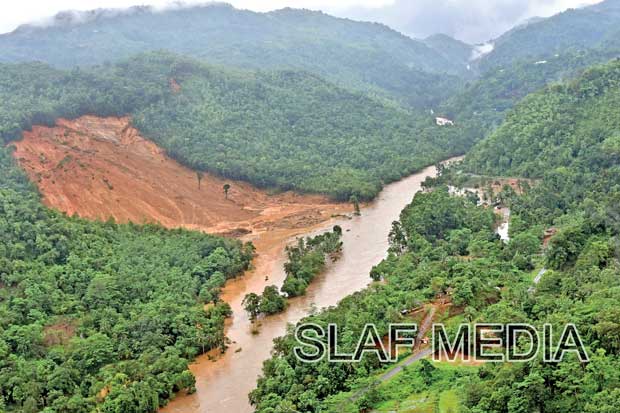 The South - West Monsoon brought Sri Lanka heavy rains, causing dreadful landslides and floods affecting many districts and more than 576,042 individuals.
The South - West Monsoon brought Sri Lanka heavy rains, causing dreadful landslides and floods affecting many districts and more than 576,042 individuals.
National Building Research Organization (NBRO) had issued landslide warnings for areas where showers could still be expected. People have already forgotten about the Monsoon accompanied misfortunes - floods, landslides and most importantly, relief. Nature has become unpredictable and we know that those floods and landslides have been an annual occurrence in the recent past, and we have been mourning with the victims, instead of taking action to mitigate them. We lack preparation and skills needed as a country to face such tragedies. People lack the attitude needed to save their own lives. Eyewitnesses said a man was waiting for a rotti and before he could make his escape, he lost his life within minutes to a landslide. 2017 May has now become unforgettable with the floods and landslides as well as the bitter lessons of nature. It’s our responsibility to make sure those natural disasters do not reccur in the coming years.

“Unusually heavy rainfalls have caused the immense landslides in the country recently. In the past, it rarely exceeded 100 millimetres but now the rainfall levels have been recorded as high as 200 and even 400 millimetres.”

Commenting on the recent landslides the professor said “This time it is not normal. Earlier, the landslides used to occur in hilly areas, but this time nearly all the landslides occurred in the foothills of mountains, where the sediments have been deposited. Normally, hilly areas have the hard rocks, that weren’t seen in these landslides. Populations are moving up the hills and continuing to build more settlements in unsuitable places without taking into account the safety standards or the hazardous elements the place may have in store,” he said.
NBRO warning
“People living in on steep slopes or close to dangerous cut slopes should be watchful. People should evacuate from the pre-landslide signs like the slant of trees or posts, sudden cracks appear on walls or the ground and sudden appearances of muddy water springs emerging from the ground. People are advised to stay alarmed of landslides in the vulnerable areas and be prepared to move away if heavy rain continues.

Mentioning recent landslides he said: “Quarries and road construction are responsible for landslides up to a certain level. But this year, many natural disasters took place due to the rare occurrence of heavy rainfall within 2- 3 hours. There are a huge number of maps and if people take good use of those maps, it will be easier to identify the weak zones that are prone to natural hazards. If the relevant authorities haven’t done it yet, it should be initiated right away.”
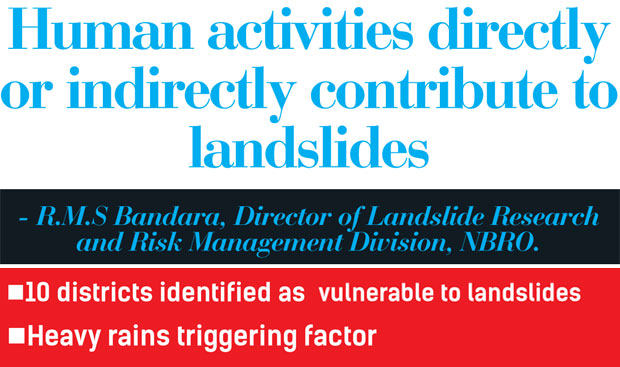
 According to the researches done by the NBRO, 10 districts have been identified as vulnerable to landslides-including Kalutara, Galle, Matara, Hambantota, Kandy, Nuwara Eliya, Matale, Kegalle, Ratnapura, and Badulla in general.
According to the researches done by the NBRO, 10 districts have been identified as vulnerable to landslides-including Kalutara, Galle, Matara, Hambantota, Kandy, Nuwara Eliya, Matale, Kegalle, Ratnapura, and Badulla in general.
Most of the recent landslides were reported from Ratnapura, Kegalle, Nuwara Eliya and Badulla. The heavy rains were a triggering factor as well as a lubricant for these- landslides.
Destruction turned to suffering
“Landslides now occur in the Moneragala - Badulla and Kurunegala slopes. Rain was the triggering factor for this year’s landslides, but the unplanned human settlements and faulty land use have also largely contributed to the disaster. There has been some kind of human activity related to most of the landslides, as per the investigations of NBRO,” he said.

“Palinda Nuwara landslide was due to improper land use; drone imagery has proof of uprooted rubber plants at the starting point of the landslides. The rubber estate was removed completely and the hollows filled by the rain water saturated the soil with water and made it unstable, causing the landslides. “The slope supported the load to move downward faster and the soil in the already open and eroded rubber estate added a massive volume to the sliding river of debris. The landslide took the weakest route down the hill and destroyed a human settlement below which was not supposed to be there,” he described.
Referring to the Aranayaka landslide he said:
“Aranayaka was a very fertile land. I think we had to keep the agriculture practices only; free from settlements. The changing trend in land usage on top of Aranayaka mountain area was the cause for the landslide that occurred in the area, which began from a small tea estate.” Commenting on the situation in Matale, he noted that spontaneous mud springs, sink-holes and cracks on earth were due to the eroding of the limestone basin under the Matale surface.
Traditionally people in the area built houses in an elevated manner accompanied with steps as a precaution to minimise flood risk.
Emphasising on the minor landslides occurring in the Gampaha District, he said that even in Ja - Ela, they were due to unregulated excavations and building houses on land propped up by retention walls.
 “Improper road construction and excavations and non- renovation of excavated slopes make the soil unstable. Therefore, whenever an extra pressure is applied to the slope; landslides occur.
“Improper road construction and excavations and non- renovation of excavated slopes make the soil unstable. Therefore, whenever an extra pressure is applied to the slope; landslides occur.
“We have noted a number of cases in hilly regions where the primary cause of a destructive landslide is being an excavated slope not refilled. Those are categorised as ‘huge’ landslides based on the amount of debris that rolled down the slope.
“There are man-made cavities in Ratnapura, as a result of the gem industry. This would cause trouble in future, if those cavities are affected by floods. The tradiotnal adage in the Ratnapura region is “Expect floods after 14 days from the (Sinhala and Tamil) New Year.
“Traditionally people in the area built houses in an elevated manner accompanied with steps as a precaution to minimise flood risk. Even the traditional knowledge of flood safety is not practised today. There were people who could guess the water level just by checking the clock tower in the Ratnapura town. Timing to get away if water levels rise,” he said.
People would assume hills as ideal places to live because they do not see how human settlements and agriculture can disturb the delicate balance
Local authorities’ failure
Lack of response and cooperation of local authorities with the NBRO, in following the recommendations and land clearance processes have been identified as a major cause for landslides in certain areas.

“To minimise harm from landslides, we have issued a circular through the Disaster Management Centre in 2011, stating that for any construction in hilly slopes, a recommendation is mandatory from NBRO. Our recommendation goes directly to the local authorities from where the plans are approved. Many local authorities are following the NBRO guidelines prior to starting projects, but we have noticed that a district which is famous for a sacred Bodhiya, is the weakest in responding to us in assistance. None of the local authorities in that district cooperate with the NBRO. That district was heavily affected by floods and landslides this year. I think the Bulathsinhala area has not practised our recommendations as well. Obviously, we do not deny the right to building houses, but those who are building houses should do it with a sound knowledge of the landscape.
“We have been trying to educate them with awareness programs and meetings to get them cooperate with us, but nobody reacted well. However, most of the local authorities cooperate. It seems that certain politicians do not stop the public from building houses in risky areas in fear of losing votes, thus losing the votes and the lives of voters.”
Threats
Building houses near river banks is dangerous due to the risk of bank collapses. The Japanese experts were here to investigate the landslides, but they were unable to proceed as our people themselves were living in danger zones on hills. “People would assume hills as ideal places to live because they do not see how human settlements and agriculture can disturb the delicate balance.
Faking tragedy
Now in this disaster situation, it is very problematic to keep count on the real victims of flood and landslide, as many fake victims are gathered in relief camps.
“While collecting data of landslides, we are carrying our investigations to identify the real victims of natural disasters. It is the same people who wouldn’t care a bit about building houses safely that are now bothering our officials to check if their houses are prone to possible threats.
Uprooted rubber plantations are one of the major reasons for floods according the Director. “The Kukule Ganga landslide was due to too much of water in the soil” he said.
He said there were no rules or methods to force replanting rubber trees again.
“The NBRO can only recommend things, we cannot force, make rules or punish the guilty. Institutions powerful enough to act upon breaking laws are therefore mandatory.”